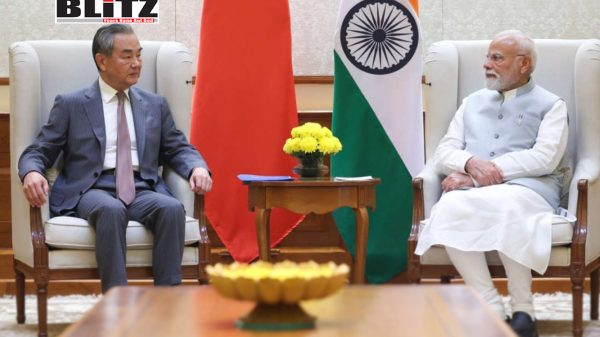Yunus regime grants free reign to jihadists who fled prisons during anti-Hasina movement
- Update Time : Thursday, August 21, 2025

One year into the country’s largest prison breaks in history when 17 district jails saw violent attacks to free over 2,000 inmates, including dangerous militants linked to the Islamic State, Ansar al-Islam, an al-Qaeda franchise, and Hizb ut-Tahrir, they are now not only posing threat to Bangladesh’s security, but also traveling abroad.
Intelligence sources say over the law few months, some jihadists have travelled to Pakistan via Nepal for training, some have intruded into India’s Northeastern states to stage sabotage, some to Saudi Arabia while latest reports say at least one has landed in the United Kingdom due to inaction of the Yunus regime to arrest them and stem the rise of extremism.
Media reports say one of the jihadists who escaped the Narsingdi District Jail on July 19 was arrested in Malaysia along with 34 others recently.
Compounding these issues, jihadist leaders from Hamas and the Taliban have made high-profile visits to Bangladesh, receiving open support from Islamist groups. On September 7, 2024, the group Al Markazul Islami hosted a major event attended by senior Hamas figures including Sheikh Khaled Quddumi and Khaled Mashaal, along with Pakistani Islamist leaders like Mufti Taqi Usmani and Maulana Fazlur Rahman. The presence of such figures on Bangladeshi soil is deeply concerning to regional security analysts, particularly in India.
On the other hand, some top jihadists, including Ansar al-Islam’s kingpin Jasimuddin Rahmani and convicted Hizb ut-Tahrir member Shafiul Islam Farabi, are out on bail and calling for jihad in India and Myanmar. Blessed by the interference of the ISI agents in the administration, including Law Adviser Asif Nazrul and Senior Home Secretary Nasimul Ghani, more jihadists are set to be released as the Yunus regime has been trying to portray them as Islamic scholars and denying the presence of militant activities. The regime also created controversy after claiming that the 2016 Gulshan Holey Artisan café attack by Islamic State operatives was not a militant attack at all.
Another most wanted militant, Shamin Mahfuz, who got bail after the August 5 jihadist coup, was rearrested by the Counterterrorism Unit of the police in July for establishing contact with the Teherik-e-Taliban Pakistan (TTP) in association with some notorious jihadists like Asif Adnan, Rezaul Karim Abrar, Zakaria Masud, Al Imran alias Engineer Imran Haider and Sanaf Hossain.
How did they escape jails?
Media reports say 13 prisoners were killed by guards during the chaos, including seven in Jamalpur and six at the Kashimpur High-Security Central Jail in Gazipur, and over 200 guards were injured during the jail breaks in July-August last year.
They also looted a huge cash of arms and ammunition.
Arms were also looted from the 450 police stations, houses of the Awami League ministers, MPs and influential leaders, and the Ganabhaban, the former prime minister’s official residence, which include 32 sophisticated arms of the Special Security Force (SSF).
Most of those looted arms have remain untraced, with the law enforcers claiming that those looted weapons have changed hands and have gone into the hands of professional criminals as well as jihadist groups various terrorist groups in the underworld. The weapons are now being used in terrorism, extortion, occupation and even murder. Many are trying to worsen the situation ahead of the elections.
A total of 17 prisons saw incidents of rebellion, with five of them – Kashimpur, Satkhira, Sherpur, Kushtia, and Narsingdi – experiencing large-scale jailbreaks when more than 2,000 prisoners escaped.
Among those who fled were death-row inmates, convicts serving life sentences, and members of outlawed militant groups. On March 10, Inspector General of Prisons Brig Gen Syed Md Motaher Hossain said about 700 prisoners were still at large, including 69 convicted of terrorism, capital offences, or life sentences.
He reiterated the same numbers on June 15, saying 724 prisoners remained in hiding. Though the exact number of escaped militants has not been disclosed, authorities said at least nine of them were among the inmates who fled from Narsingdi prison.
On July 19, the first major prison attack occurred in Narsingdi during the peak of the student protests. Mass jailbreaks followed on August 6, a day after the government was toppled.
On that day, 202 inmates escaped from Kashimpur’s high-security facility after launching an internal rebellion. The number of militants who escaped, however, is still unclear.
On August 5, the attack on the Sherpur District Jail was launched by thousands of people who came with a procession. The attackers broke through the main gate, looted cash, food, weapons, and ammunition, and set the facility on fire. According to prison authorities, 518 inmates escaped.
Police say they are struggling to arrest the escaped militants due to lack of documents, which were burned during the attacks. However, security experts say the Yunus regime is giving free reign to the jihadists as it continues to patronize them for large scale attacks in India to destabilize the region.











